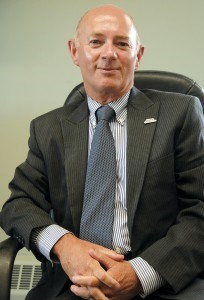
For the third consecutive year, Mayor Richard Ireland presented the business community with a State of the Municipality address, May 12, covering everything from the long overdue library and cultural centre to concerns about the mountain pine beetle and the changing Temporary Foreign Worker program.
Most significantly, though, Ireland spent the majority of his time speaking to members of the Jasper Park Chamber of Commerce about the municipality’s need for alternative revenue sources in order to alleviate the tax burden borne by the communities property owners.
As a tourism-based community, Jasper is required to provide services, facilities and infrastructure for a far greater number of people than pay municipal taxes and yet, said Ireland, property taxes are currently one of the municipality’s only methods of collecting revenue—with service fees being the other.
Currently, Jasper has a five-to-one tax split, with commercial businesses paying five times the rate of residential taxpayers.
Ireland acknowledged that split and thanked business owners for “shouldering that burden.”
“The existing legislative framework is unsuited to—perhaps incapable of—recognizing or addressing our distinctive characteristics and challenges as tourism-based communities,” he said.
So, said Ireland, within the existing provincial framework, taxing businesses at a higher rate is the only way the municipality can pass on some of the cost to the town’s visitors.
But, he said there are other options.
“Defining tourism-based communities as a distinct municipal structure under the provincial Municipal Government Act is the first step,” said Ireland, who has been personally working with the mayors and chief administrative officers from Banff and Canmore to lobby the provincial government for a special status and revenue source for tourism-based communities.
Ireland pointed to British Columbia, as well as tourism-based communities in the United States, as examples of jurisdictions with a specific model to more appropriately fund resort municipalities.
In an effort to make a model for Alberta, Jasper, Banff and Canmore are currently drafting a report quantifying their need for alternative revenue sources.
“Our interest is focused on truly alternative revenue sources. It is not our intent to reapportion existing funding to our benefit with consequences of diminished funding for other entities or organizations.
“To meet the needs of tourism-based communities, the pie must be enlarged.”
As well as the need for alternative revenue sources, Ireland spoke of the municipality’s efforts to lobby the federal government for changes to the town’s governance agreement, eliminating Jasper’s land rent.
“Our land rent payment represents approximately nine per cent of our municipal tax bill. That’s money that’s collected locally and shipped off to Ottawa.
“Imagine if we could eliminate a payment of that magnitude; or imagine if we simply had that amount to spend on local needs, to improve our product.”
Although land rent and Alberta's property tax model are burdensome, Ireland said the municipality continues to provide the service levels expected of it—and it accomplishes that because of a balanced budget.
“That, too, is an indicator of community health,” said Ireland, who began his speech explaining that community health is council’s first priority. “It’s a credit to our administrative staff, past and present, and it sets the foundation for a healthy future.”
Ireland closed his speech by discussing collaboration—a common theme in his State of the Municipality addresses—as well as highlighting Jasper’s human capacity “to make good things happen.”
He pointed to the SEED initiative, the museum roof, PJ Day, the J9 Sparkle Run and numerous other events, sports teams and organizations as examples of this, saying “Jasper proves capacity.”
“And that happens only because residents engage. Engagement—caring about your community to the extent that you do something to improve it—is the hallmark of a healthy community.
“At the municipality we strive to provide the secure foundation upon which community health can flourish.
“I think we’re doing exactly that: I hope you agree.”
